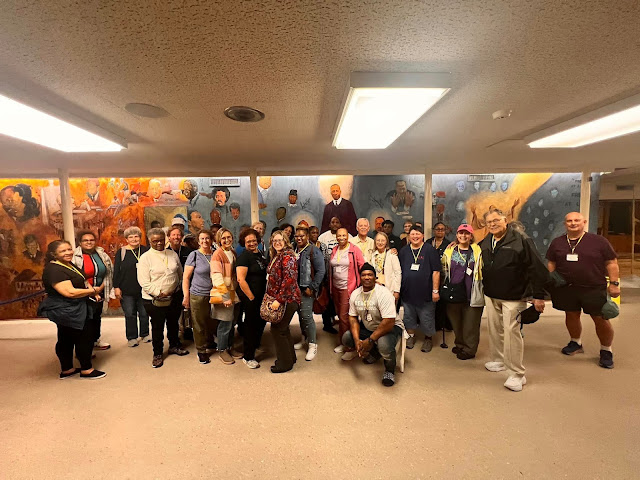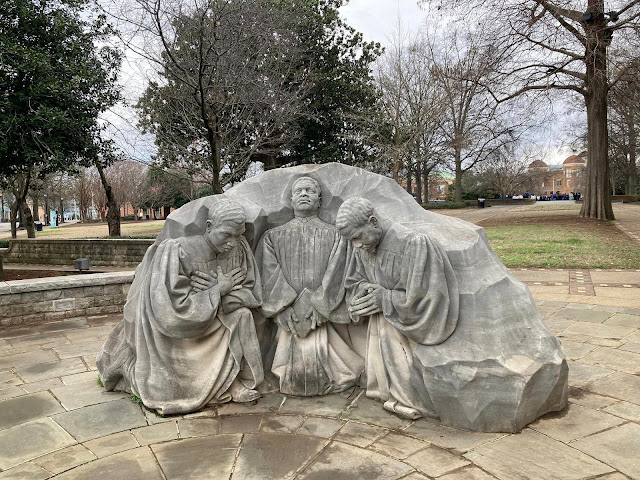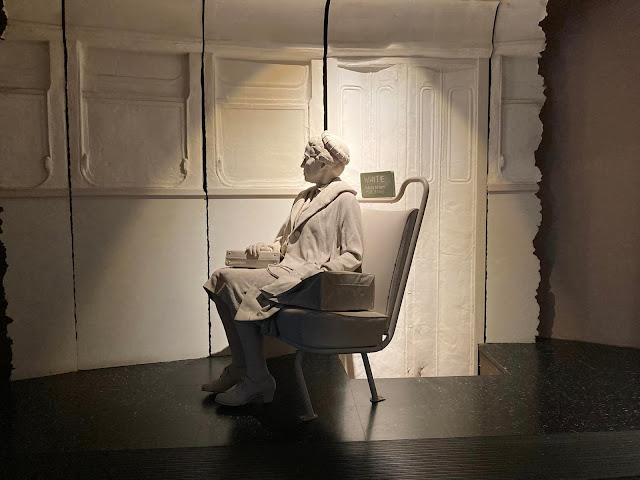- Get link
- X
- Other Apps
- Get link
- X
- Other Apps
 |
| A photo of the pilgrimage group at the Dexter Avenue Chapel |
I just returned from the Alabama Civil Rights Pilgrimage. It's put on by the Mt. Level Community Partnership for Racial Justice. The partnership is made of 10 churches and organizations in Durham. Our group was made of 30 people, including our bus driver. You had to apply, and they wanted pilgrims who are white and Black.
We traveled by bus to Birmingham, Marion, Selma, and Montgomery, following the path, both geographically and chronologically, of Civil Rights heroes of the faith. I heard about the trip a year ago and told myself that if they did it again, I would apply. When they announced the trip, I applied within the hour.
During the trip we visited important historical sites and heard from foot soldiers who were on site during the demonstrations that were held to end segregation and grant Black citizens the right to vote. The last day was probably the most powerful, and we visited the Memorial for Peace and Justice and the Legacy Museum, both in Montgomery and founded by Bryan Stephenson's Equal Justice Initiative. Here are my reflections on the full itinerary each day of the trip.
Day 1: Birmingham to Marion
We started by visiting Kelly Ingram Park, site of the Children's Crusade of 1963. Children joined in the movement for desegregation by gathering at the 16th Street Baptist Church. Their peaceful demonstration was met with police dogs, high-powered water hoses, and batons. But the publicity from the event worked. The President got involved. After a week, city leaders agreed to negotiate with the leaders. The brave children were taken to prison. Reportedly Bull Connor asked to Dr. King to stop sending out children in the middle of the hosing so that the firefighters could stop for a lunch break. They were no match for these children.

This statue in the park commemorates children who had hoses turned against them. The force of the blasts was enough to take bark off trees. Some of the kids lost clothing and hair. However, the water would slam down the kids, but the kids would continue to come. And at the end, there were still 10 kids standing against the blasts. The kids were trained by Reverend James Bevel, but the kids volunteered for the assignment. I am in awe of these kids who would do this. I have never been in jail and have certainly never been hosed by hoses meant to put out city fires.

Three Kneeling Minsters statue. The children's march was not the original plan. The adults would never send their kids unless it was necessary. When Dr. King, Ralph Abernathy, and Fred Shuttlesworth lead a demonstration in April (one month before the Crusade), they were met by police and kneeled to pray. A reminder that these acts of civil disobedience were lead by men of the spirit.

Next we toured the 16th Street Baptist Church where the march started and also where a bomb killed four little girls. I was quite taken with the statue outside the commemorate their death, called Four Spirits.

The end of the Crusade was a negotiation of sorts to end segregation in businesses. But not everyone was pleased. The Crusade was followed by a bombing. A Klan member set a bomb on September of 1963. It was put underneath a set of stairs. The bomb killed four girls in the ladies lounge and blinded another. That same day, two boys not connected to the church were killed in Klan related accidents. I was quite taken with this statue.

A secret detail. The book has a poem engraved on it. The Stolen Child by WB Yeats, about fairies who seduced children to escape the troubles of life into fairy land. Beautiful and sad lyrics.
 |
| A statue of Rosa Parks |
We then went to the Birmingham Civil Rights Institute and toured the facility. We didn't have long inside.
 |
| This replica jail cell helps to remember Dr. King's time in prison where he wrote Letter from Birmingham Jail. |
We then went to Trinity UMC and heard from two sisters, who were foot soldiers in the march. They shared their memories of the day.
We then traveled to Marion, AL and had dinner at the historic Lincoln Normal school. The school was built to educate newly freed African Americans after the Civil War and was funded by both Black and white citizens of the town. There's a good documentary about the school that is worth watching. It became notable for training African American to be leaders. The school also had a very talented choir who would tour the Midwest. This part might be interesting to my parents. To protect the kids, the bus had windows that were painted white and a divider that the kids would hide behind if they were stopped.
All of this is significant because as we learned the next day, Marion was also a significant place in the Civil Rights Movement as a whole. And maybe the presence of the Lincoln school is what helped to prepare people who would be brave enough to stand. Leadership always has a root somewhere of someone investing in you. More info in the pictures captions.
Day 2: Marion to Montgomery by way of Selma
Zion Church, where the Marion march began. They were going to the jail to make sure Reverend James Orange was not lynched.
 |
| A foot soldier speaks in front of a poster of Jimmie Lee Jackson |
We started out the day at Zion UMC church in Marion to hear from foot soldier Della Mayor. She participated in the demonstration that left from that church during which Jimmie Lee Jackson was murdered while protecting his grandfather from being beaten by troopers. The reason for the demonstration was they were going to the jail to protect Reverend James Orange. He was in prison, and there was talk that a mob would lynch him that evening. So they were headed for the jail. We walked down to the jail, as the crowd would have. This was in February of 1965.
 |
| Brown Chapel in Selma |
We then drove to Selma, passing by Jimmie Lee Jackson's grave on the way. It was not possible to stop. Selma was a sight to see. There is a lot of trauma in the city and that is reflected in the structures, showing the neglect of this town. We stopped at Brown Chapel which is where the marches from Selma to Montgomery started. The first of these was March 7, 1965, called Bloody Sunday. Part of the catalyst for the marches was the death of Jimmie Lee Jackson.
We then walked over the Edmund Pettus Bridge, and there were a few monuments to leaders, as well as a rock that commemorated a lynching tree.
We then walked over the Edmund Pettus Bridge, and there were a few monuments to leaders, as well as a rock that commemorated a lynching tree.
 |
| Me getting ready to cross the bridge |
Getting ready to cross the bridge. It was a long walk, about 10 minutes. The first march on Bloody Sunday, the marchers stayed on the pedestrian sidewalk. The second time, they filled the road.

We then made a pit stop at Lowndes County Interpretive Center. They had a setup of a tent city. These tent cities were setup as Black citizens registered to vote. They would often lose their jobs over this decision and be thrown out of their homes by angry landlords. The tent cities were places they could live while they found other accommodations.

Our last stop of the day was the Dexter Avenue church and parsonage, where Dr. King lived during much of the movement. The church was cool, but the house was excellent. We were unable to take pictures in the house due to security concerns. But it looked a lot like my house with a hugely pink mid century bathroom. The kitchen table is of great import. Dr. King was unsure if God truly wanted him to do this work. One evening he poured himself a cup of coffee and heard God call him by name.
 |
| Inside of Dexter Avenue church |
In the basement of the church is Dr. King's pulpit. It was signed by David Oyelowe, who played Dr. King in the movie Selma. Oyelowe was allowed to use the pulpit in the movie.

We took turns putting our hands on the pulpit to show our solidarity. Different skin tones, but the same heart.
Day 3: Montgomery

We took turns putting our hands on the pulpit to show our solidarity. Different skin tones, but the same heart.
Day 3: Montgomery
 |
| Southern Poverty Law Center Memorial |
This was probably the most challenging day. But the most powerful and impactful.
We started the day at the Southern Poverty Law Center Memorial. It is very close to the Dexter Avenue Church. The engraving is from Amos 5:24: "We will not be satisfied until justice rolls down like waters and righteousness like a mighty stream." The water flows continuously and is next to a sundial that commemorates major events and people of the movement.
We started the day at the Southern Poverty Law Center Memorial. It is very close to the Dexter Avenue Church. The engraving is from Amos 5:24: "We will not be satisfied until justice rolls down like waters and righteousness like a mighty stream." The water flows continuously and is next to a sundial that commemorates major events and people of the movement.

We then drove by Mothers of Gynecology Park, which commemorates the contributions of Anarcha, Lucy, and Betsey to modern day gynecology. Dr. Sims, known as the father of gynecology, did experiments on these enslaved women without anesthesia in his studies on repairing fistulas. As enslaved women, they were not asked for consent. They may have wanted to be cured of their ailments, but there was a misguided belief that Black women did not experience pain the same as white women. I did not take any pictures because I was so horrified, but I included one in my scrapbook that I found online. I had heard about this Dr. Sims before but just hadn't connected all the dots yet.

We then visited the Memorial of Peace and Justice, sometimes called the lynching museum. That name is problematic in my opinion though. You are greeted by a statue of enslaved people bound for buying and selling.

This first statue almost kept me from moving. It was lifelike.

The next stage transitions to a memorial for all known lynchings in the United States. They are placed in a spiral, starting with the state of Alabama and going in to a center. Each pylon represents one county. I looked for those taking place in North Carolina and Indiana but saw many other things on the way. The ending is another statue, representing the Black person in America today.

At the end of the monuments is this statue that depicts how often Black men are pulled over, frisked, and interrogated for the most minor of offenses. Often these incidents end in murder, with little to no consequences. There is a narrative that Black people are inherently dangerous to they have to be controlled.
The last part of our visit was the Legacy Museum. Both the Memorial of Peace and Justice and the Legacy Museum or founded by the Equal Justice Initiative, Bryan Stephenson's foundation. The museum is a journey into the Black experience from enslavement to mass incarceration, making a case and proving that enslavement, lynching, segregation, and mass incarceration are all the same thing with different dressing. Each has mechanisms in society meant to keep Black people at a disadvantage and in their place.
The museum is immersive and almost too much to bear. How do you handle so much suffering? I have attempted with these pictures to just bear witness to what I have seen and what I witnessed. There is much to process. I do recommend you pay this place a visit. I will never forget it. If you want to hear more about my trip, I am happy to discuss with anyone. And I will be making a podcast soon, as well as doing a live debrief at my church.
At the last night of the trip, the group met and shared reflections. I talked about a phrase that kept popping into my head on the last day: "Who can understand it?" Upon returning to my room, I looked up if this was in the Bible. I found Jeremiah 17:9-10: "The heart is deceitful above all things, and desperately sick; who can understand it?" Yes, what happened to Black and brown fellow humans is evil and desperately sick. Who can understand and how can anyone look at a fellow human and think it was okay or suitable to enslave someone, beat them, or separate families. Because the heart is sick.

But then I found a ray of hope. The second verse with this phrase said: "Evil men do not understand justice, but those who seek the Lord understand it completely." Proverbs 28:5. Having our minds renewed by the saving blood of Jesus allows us to see justice through His eyes.



Comments